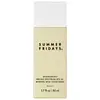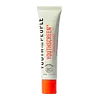What's inside
What's inside
 Key Ingredients
Key Ingredients

 Benefits
Benefits

 Concerns
Concerns

 Ingredients Side-by-side
Ingredients Side-by-side

Zinc Oxide 9.4%
Cosmetic ColorantWater
Skin ConditioningC12-15 Alkyl Benzoate
AntimicrobialSorbitan Oleate Decylglucoside Crosspolymer
CleansingArgania Spinosa Kernel Oil
EmollientTocopheryl Acetate
AntioxidantAmmonium Acryloyldimethyltaurate/Vp Copolymer
Glycerin
HumectantCaramel
Cosmetic ColorantPolyester-5
Squalane
EmollientButyrospermum Parkii Butter Extract
Skin ConditioningBisabolol
MaskingPhospholipids
Skin ConditioningTocopherol
AntioxidantEthyl Ferulate
AntioxidantUrea
BufferingEthylhexylglycerin
Skin ConditioningGluconolactone
Skin ConditioningTriethoxycaprylylsilane
Dimethicone
EmollientSodium Chloride
MaskingBenzyl Alcohol
PerfumingSodium Benzoate
MaskingSorbic Acid
PreservativeChlorphenesin
AntimicrobialPhenoxyethanol
PreservativeZinc Oxide 9.4%, Water, C12-15 Alkyl Benzoate, Sorbitan Oleate Decylglucoside Crosspolymer, Argania Spinosa Kernel Oil, Tocopheryl Acetate, Ammonium Acryloyldimethyltaurate/Vp Copolymer, Glycerin, Caramel, Polyester-5, Squalane, Butyrospermum Parkii Butter Extract, Bisabolol, Phospholipids, Tocopherol, Ethyl Ferulate, Urea, Ethylhexylglycerin, Gluconolactone, Triethoxycaprylylsilane, Dimethicone, Sodium Chloride, Benzyl Alcohol, Sodium Benzoate, Sorbic Acid, Chlorphenesin, Phenoxyethanol
Water
Skin ConditioningHomosalate
Skin ConditioningGlycerin
HumectantEthylhexyl Salicylate
UV AbsorberC15-19 Alkane
SolventPropanediol
SolventEthylhexyl Methoxycrylene
Skin ConditioningButyl Methoxydibenzoylmethane
UV AbsorberButyloctyl Salicylate
Skin ConditioningC12-22 Alkyl Acrylate/Hydroxyethylacrylate Copolymer
StabilisingSodium Stearoyl Glutamate
CleansingTocopherol
AntioxidantCetearyl Alcohol
EmollientSclerotium Gum
Emulsion StabilisingPhenoxyethanol
PreservativeHydroxyacetophenone
AntioxidantCaprylyl Glycol
EmollientSodium Starch Octenylsuccinate
AbsorbentGlyceryl Stearate
EmollientJojoba Esters
EmollientParfum
MaskingHelianthus Annuus Seed Cera
EmollientHydroxypropyl Starch Phosphate
Glycine Soja Oil
EmollientTrisodium Ethylenediamine Disuccinate
Bisabolol
MaskingSodium Hydroxide
BufferingPentylene Glycol
Skin ConditioningPropylene Glycol
HumectantTaraxacum Officinale Rhizome/Root Extract
Skin ConditioningAloe Barbadensis Leaf Juice Powder
Skin ConditioningPolyglycerin-3
HumectantCamellia Sinensis Leaf Extract
AntimicrobialMedicago Sativa Extract
TonicDextrin
AbsorbentChamomilla Recutita Flower Extract
MaskingLimonene
PerfumingSodium Benzoate
MaskingPotassium Sorbate
PreservativeBrassica Oleracea Acephala Leaf Extract
HumectantCitric Acid
BufferingWater, Homosalate, Glycerin, Ethylhexyl Salicylate, C15-19 Alkane, Propanediol, Ethylhexyl Methoxycrylene, Butyl Methoxydibenzoylmethane, Butyloctyl Salicylate, C12-22 Alkyl Acrylate/Hydroxyethylacrylate Copolymer, Sodium Stearoyl Glutamate, Tocopherol, Cetearyl Alcohol, Sclerotium Gum, Phenoxyethanol, Hydroxyacetophenone, Caprylyl Glycol, Sodium Starch Octenylsuccinate, Glyceryl Stearate, Jojoba Esters, Parfum, Helianthus Annuus Seed Cera, Hydroxypropyl Starch Phosphate, Glycine Soja Oil, Trisodium Ethylenediamine Disuccinate, Bisabolol, Sodium Hydroxide, Pentylene Glycol, Propylene Glycol, Taraxacum Officinale Rhizome/Root Extract, Aloe Barbadensis Leaf Juice Powder, Polyglycerin-3, Camellia Sinensis Leaf Extract, Medicago Sativa Extract, Dextrin, Chamomilla Recutita Flower Extract, Limonene, Sodium Benzoate, Potassium Sorbate, Brassica Oleracea Acephala Leaf Extract, Citric Acid
 Reviews
Reviews

Ingredients Explained
These ingredients are found in both products.
Ingredients higher up in an ingredient list are typically present in a larger amount.
Bisabolol is famous for its skin soothing properties. It does this by blocking inflammatory signals, helping to reduce your body's reaction to irritation.
This ingredient also interferes with the process of hyperpigmentation. This can help with reducing dark spots and uneven tone.
Bisabolol is an antioxidant. Antioxidants help fight free-radicals. Free-radicals are molecules that may damage your skin cells. By fighting these free-radicals, Bisabolol may slow down signs of aging.
Studies have shown Bisabolol to have antimicrobial properties and may be a fungicide. These properties help preserve a product's shelf life.
All these properties makes bisabolol a great skin barrier helper ingredient.
Bisabolol also helps the absorption of other ingredients.
Note: Synthetic Bisabolol has been shown to be less effective.
Learn more about BisabololGlycerin is already naturally found in your skin. It helps moisturize and protect your skin.
A study from 2016 found glycerin to be more effective as a humectant than AHAs and hyaluronic acid.
As a humectant, it helps the skin stay hydrated by pulling moisture to your skin. The low molecular weight of glycerin allows it to pull moisture into the deeper layers of your skin.
Hydrated skin improves your skin barrier; Your skin barrier helps protect against irritants and bacteria.
Glycerin has also been found to have antimicrobial and antiviral properties. Due to these properties, glycerin is often used in wound and burn treatments.
In cosmetics, glycerin is usually derived from plants such as soybean or palm. However, it can also be sourced from animals, such as tallow or animal fat.
This ingredient is organic, colorless, odorless, and non-toxic.
Glycerin is the name for this ingredient in American English. British English uses Glycerol/Glycerine.
Learn more about GlycerinPhenoxyethanol is a preservative that has germicide, antimicrobial, and aromatic properties. Studies show that phenoxyethanol can prevent microbial growth. By itself, it has a scent that is similar to that of a rose.
It's often used in formulations along with Caprylyl Glycol to preserve the shelf life of products.
Sodium Benzoate is a preservative. It's used in both cosmetic and food products to inhibit the growth of mold and bacteria. It is typically produced synthetically.
Both the US FDA and EU Health Committee have approved the use of sodium benzoate. In the US, levels of 0.1% (of the total product) are allowed.
Sodium benzoate works as a preservative by inhibiting the growth of bacteria inside of cells. It prevents the cell from fermenting a type of sugar using an enzyme called phosphofructokinase.
It is the salt of benzoic acid. Foods containing sodium benzoate include soda, salad dressings, condiments, fruit juices, wines, and snack foods.
Studies for using ascorbic acid and sodium benzoate in cosmetics are lacking, especially in skincare routines with multiple steps.
We always recommend speaking with a professional, such as a dermatologist, if you have any concerns.
Learn more about Sodium BenzoateTocopherol (also known as Vitamin E) is a common antioxidant used to help protect the skin from free-radicals and strengthen the skin barrier. It's also fat soluble - this means our skin is great at absorbing it.
Vitamin E also helps keep your natural skin lipids healthy. Your lipid skin barrier naturally consists of lipids, ceramides, and fatty acids. Vitamin E offers extra protection for your skin’s lipid barrier, keeping your skin healthy and nourished.
Another benefit is a bit of UV protection. Vitamin E helps reduce the damage caused by UVB rays. (It should not replace your sunscreen). Combining it with Vitamin C can decrease sunburned cells and hyperpigmentation after UV exposure.
You might have noticed Vitamin E + C often paired together. This is because it is great at stabilizing Vitamin C. Using the two together helps increase the effectiveness of both ingredients.
There are often claims that Vitamin E can reduce/prevent scarring, but these claims haven't been confirmed by scientific research.
Learn more about TocopherolWater. It's the most common cosmetic ingredient of all. You'll usually see it at the top of ingredient lists, meaning that it makes up the largest part of the product.
So why is it so popular? Water most often acts as a solvent - this means that it helps dissolve other ingredients into the formulation.
You'll also recognize water as that liquid we all need to stay alive. If you see this, drink a glass of water. Stay hydrated!
Learn more about Water